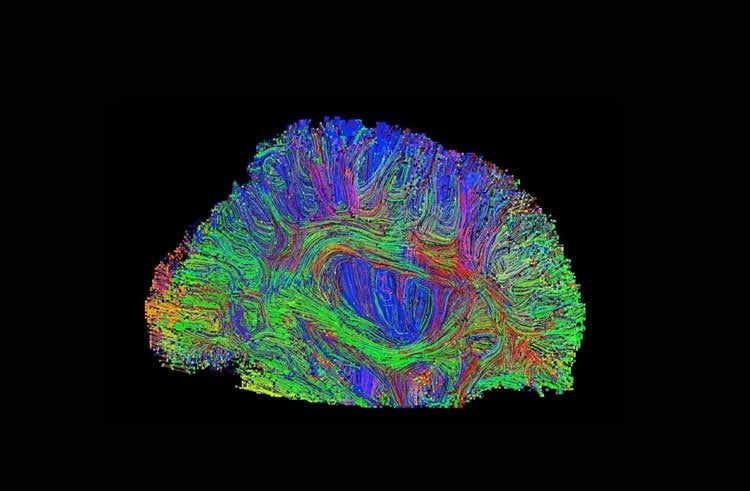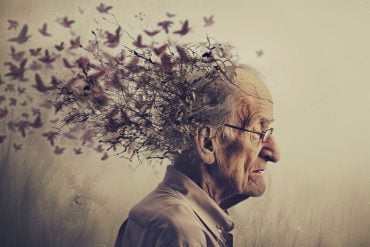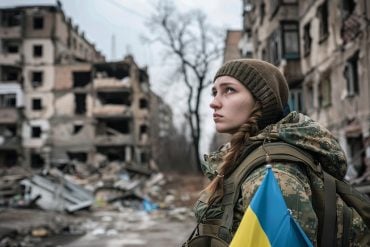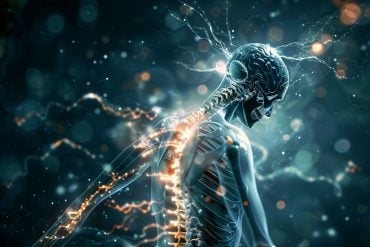Summary: Researchers have identified seven genes that predict intracranial volume and Parkinson’s disease.
Source: USC.
USC researchers lead an international team identifying 7 genes that predict ‘intracranial volume’ and Parkinson’s disease.
Brain size may matter. In the world’s largest MRI study on brain size to date, USC researchers and their international colleagues identified seven genetic hotspots that regulate brain growth, memory and reasoning as well as influence the onset of Parkinson’s disease.
Most brain imaging studies evaluate around 100 people, but the Nature Neuroscience study published on Oct. 3 examined 32,438 adults, said Paul Thompson, a corresponding author and associate director of the USC Mark and Mary Stevens Neuroimaging and Informatics Institute. The results bring scientists closer to understanding the genetic program that builds the living brain.
“Brain measures from MRI account for about 15 percent of the differences in our cognitive ability — that is, brain-based skills required to perform simple and complex tasks,” said Thompson, who led a team of more than 300 international scientists. “The genes underlying brain development have far-reaching effects that extend well beyond the initial years of life. You have genes that are beneficial for you and help build brain structures early in life. Yet some of these are harmful later in life and promote diseases such as Parkinson’s.”
Parkinson’s disease is a progressive disorder of the nervous system that affects movement and often leads to tremors. Like many other degenerative brain disorders, a cure does not yet exist.
Although scientists have not determined an ideal healthy brain size, a brain that is too small (microcephaly) or too big (macrocephaly) can lead to abnormal cognitive development and lifelong challenges. The human brain reaches maximum size around a person’s early 20s, Thompson said.
The study used data on subjects from 52 study sites that are part of the Cohorts for Heart and Aging Research in Genomic Epidemiology consortium and Enhancing Neuro Imaging Genetics through Meta Analysis (ENIGMA) consortium, which is based at USC and led by Thompson. The research supports the notion that brain size could be used as a measure of “brain reserve,” meaning brain size can promote resilience to age-related brain diseases.
ENIGMA is part of the USC Mark and Mary Stevens Neuroimaging and Informatics Institute, which aims to enhance discovery through the application of imaging and information techniques in the study of the brain. The institute is a leader in data acquisition, analysis stewardship and computational innovation for the purpose of biomedical research.
Genes and environment come into play
Both genetics and environmental factors affect brain size. Good diet, education and exercise build a healthy brain in young people and protect older people from tissue loss.
“This research is on the leading edge of cracking the brain’s genetic code,” Thompson said. “Millions of people carry variations in their DNA that help boost or lower their brains’ susceptibility to a vast range of diseases. Once we identify these genes, we can target them with drugs to reduce the risk of disease. People also can take preventive steps through exercise, diet and mental stimulation to erase the effects of a bad gene.”
The study began seven years ago. Its technique of using brain scans to identify gene hotspots provides more information than the traditional method of collecting DNA samples from patients.
“Now that we can see a gene’s imprint in brain scans, it’s like capturing a thief red-handed,” Thompson said. “You can chase it down brain pathways and circuits and discover what brain cells the gene is damaging. Using brain scans builds a foundation so that scientists in the future can better focus their studies on hotspots of interest.”
The seven genes and what they do
Thompson and his colleagues identified five new gene hubs that predict brain growth and confirmed two known hotspots. The genes in these areas provide links between an individual’s maximum brain size and processes such as:
- the production of self-renewing stem cells (FOXO3)
- brain degeneration (MAPT)
- bone density (CENPW)
- physical growth (IGF1, HMGA2)
- DNA replication (GMNC)
- the creation of chemical bonds and proteins (PDCD).
Researchers adjusted their data for height and confirmed growth predictions by examining 2,824 children from before birth until age 6.

Of note, one of the areas of the human genome that affects brain size has a normal version and an inverted alphabet variant that evolved some 3 million years ago, Thompson said.
“MAPT is one of the most dangerous genes in this inverted zone,” he said. “It is implicated in neurodegenerative diseases such as frontotemporal dementia and Parkinson’s, Alzheimer’s and Lou Gehrig’s disease. Even in the normal brain-size range, brain scans reveal telltale signs of future disease.”
Ongoing studies may reveal additional brain conditions that are promoted by the tau-associated MAPT gene, Thompson said.
“The genetic program that builds our brains consists of growth factors, cancer genes, genes that promote dementia and genes that are crucial in helping the brain to form connections,” Thompson said. “A complex interplay of factors makes some genes that are beneficial in early life go rogue later in life. It’s extremely important to understand when genes that affect brain size — such as the MAPT gene — are helpful and what parts of the brain they are influencing.”
Source: Zen Vuong – USC
Image Source: NeuroscienceNews.com image is credited to Paul Thompson/ENIGMA Center, USC.
Original Research: Abstract for “Novel genetic loci underlying human intracranial volume identified through genome-wide association” by Hieab H H Adams, Derrek P Hibar, Vincent Chouraki, Jason L Stein, Paul A Nyquist, Miguel E Rentería, Stella Trompet, Alejandro Arias-Vasquez, Sudha Seshadri, Sylvane Desrivières, Ashley H Beecham, Neda Jahanshad, Katharina Wittfeld, Sven J Van der Lee, Lucija Abramovic, Saud Alhusaini, Najaf Amin, Micael Andersson, Konstantinos Arfanakis, Benjamin S Aribisala, Nicola J Armstrong, Lavinia Athanasiu, Tomas Axelsson, Alexa Beiser, Manon Bernard, Joshua C Bis, Laura M E Blanken, Susan H Blanton, Marc M Bohlken, Marco P Boks, Janita Bralten, Adam M Brickman, Owen Carmichael, M Mallar Chakravarty, Ganesh Chauhan, Qiang Chen, Christopher R K Ching, Gabriel Cuellar-Partida, Anouk Den Braber, Nhat Trung Doan, Stefan Ehrlich, Irina Filippi, Tian Ge, Sudheer Giddaluru, Aaron L Goldman, Rebecca F Gottesman, Corina U Greven, Oliver Grimm, Michael E Griswold, Tulio Guadalupe, Johanna Hass, Unn K Haukvik, Saima Hilal, Edith Hofer, David Hoehn, Avram J Holmes, Martine Hoogman, Deborah Janowitz, Tianye Jia, Dalia Kasperaviciute, Sungeun Kim, Marieke Klein, Bernd Kraemer, Phil H Lee, Jiemin Liao, David C M Liewald, Lorna M Lopez, Michelle Luciano, Christine Macare, Andre Marquand, Mar Matarin, Karen A Mather, Manuel Mattheisen, Bernard Mazoyer, David R McKay, Rebekah McWhirter, Yuri Milaneschi, Nazanin Mirza-Schreiber, Ryan L Muetzel, Susana Muñoz Maniega, Kwangsik Nho, Allison C Nugent, Loes M Olde Loohuis, Jaap Oosterlaan, Martina Papmeyer, Irene Pappa, Lukas Pirpamer, Sara Pudas, Benno Pütz, Kumar B Rajan, Adaikalavan Ramasamy, Jennifer S Richards, Shannon L Risacher, Roberto Roiz-Santiañez, Nanda Rommelse, Emma J Rose, Natalie A Royle, Tatjana Rundek, Philipp G Sämann, Claudia L Satizabal, Charles DeCarli, Emma Sprooten, Thomas E Nichols, Marcel P Zwiers, Iwona Kloszewska, Luigi Ferrucci, Diana Tordesillas-Gutierrez, Michael E Weale, David S Knopman, Robert C Green, Anbupalam Thalamuthu, Andreas Meyer-Lindenberg, Sebastian Mohnke, Philippe Amouyel, John B Kwok, Simon E Fisher, Dick J Veltman, Robert Johnson, Margaret J Wright, Pieter J Hoekstra, Andreas Heinz, Thomas H Wassink, Ingrid Melle, Bertram Müller-Myhsok, Sven Cichon, Ole A Andreassen, Sebastian Guelfi, Lianne Schmaal, Dan L Longo, Girma Woldehawariat, Masaki Fukunaga, Ching-Yu Cheng, Dara M Cannon, Russell Thomson, Bing Xu, Simon Lovestone, Oliver Gruber, Alan B Zonderman, Jessika E Sussmann, Ryota Kanai, Juan Troncoso, Derek W Morris, Lachlan T Strike, Tomas Paus, Brenda W J H Penninx, Michael Czisch, Colin Smith, Tien Y Wong, Jordan W Smoller, Beng-Choon Ho, Jessica A Turner, Jean Shin, Marcel Van der Brug, Andrew Singleton, Chantal Depondt, Neeltje E M Van Haren, Marcella Rietschel, Erik G Jönsson, Zdenka Pausova, Anderson M Winkler, David A Bennett, Greig I de Zubicaray, Ingrid Agartz, Myriam Fornage, Massimo Pandolfo, Alex Zijdenbos, Vilmundur Gudnason, Badri N Vardarajan, Venkata S Mattay, Mark Jenkinson, Vince D Calhoun, Tonya White, Dena G Hernandez, Anton J M De Craen, Rachel M Brouwer, Sarah E Medland, Thomas Wolfers, Christophe Tzourio, Norman Delanty, Markus M Nöthen, M Arfan Ikram, Simone Reppermund, John Blangero, Henrik Walter, Sampath Arepalli, Srdjan Djurovic, Eric Westman, Dennis Van der Meer, René S Kahn, Lisa R Yanek, J Wouter Jukema, Katrin Hegenscheid, Ralph L Sacco, Michael A Nalls, Ravi Duggirala, Steven G Potkin, Lenore J Launer, Ryota Hashimoto, Benedicto Crespo-Facorro, Francis J McMahon, Wayne C Drevets, Lars Nyberg, Helena Schmidt, Velandai Srikanth, Mark E Bastin, Dennis Van ′t Ent, Andrew J Saykin, Albert Hofman, Guillén Fernández, Andrew M McIntosh, Peter Kochunov, Elena Shumskaya, David C Glahn, Anita L DeStefano, Norbert Hosten, Narelle K Hansell, G Bruce Pike, Peter R Schofield, Georg Homuth, Gunter Schumann, Sigurdur Sigurdsson, Anders M Dale, H Ronald Zielke, Andre G Uitterlinden, Sandra Barral, Hans J Grabe, W T Longstreth Jr, Daniel R Weinberger, Dorret I Boomsma, Jeroen Van der Grond, Hilkka Soininen, Philip L De Jager, Harald H H Göring, Stéphanie Debette, Katie L McMahon, Diane M Becker, Theo G M Van Erp, Masashi Ikeda, Cornelia M Van Duijn, Hervé Lemaître, Rene L Olvera, Daniah Trabzuni, Daan Van Rooij, Stephanie Le Hellard, Marjolein M J Van Donkelaar, Andy Simmons, Oscar L Lopez, Patrizia Mecocci, Debra A Fleischman, John Hardy, Gary Donohoe, Xinmin Liu, Wolfgang Hoffmann, Jan K Buitelaar, Mina Ryten, James T Becker, David J Stott, Nicholas G Martin, Catharina A Hartman, Gianpiero L Cavalleri, Ian J Deary, Reinhold Schmidt, Bryan J Traynor, Jean-Luc Martinot, Amelia A Assareh, Kazutaka Ohi, Joanna M Wardlaw, Paul M Thompson, M Kamran Ikram, Dhananjay Vaidya, Thomas W Mühleisen, Gareth E Davies, Laura Almasy, Marie-Jose Van Tol, Jerome I Rotter, Jingyun Yang, Clifford R Jack Jr, Lars T Westlye, Nina Romanczuk-Seiferth, Stephen M Lawrie, Christiane Wolf, Vidar M Steen, Michael W Weiner, Esther Walton, Wiro J Niessen, Grant W Montgomery, Kazima B Bulayeva, Randy L Gollub, Henry Brodaty, Henning Tiemeier, Kristel R Van Eijk, Sanjay M Sisodiya, Hilleke E Hulshoff Pol, Albert V Smith, Andrew J Schork, Florian Holsboer, Maria C Valdés Hernández, Christopher Chen, Peter T Fox, Joanne E Curran, Clyde Francks, Han G Brunner, Ian Ford, Matthias Nauck, Oliver Martinez, Aad Van der Lugt, Susanne Erk, Denis A Evans, Eco J C De Geus, J Raphael Gibbs, Tatiana M Foroud, Meike W Vernooij, Henry Völzke, Allissa Dillman, Colm McDonald, Roberto Toro, Christopher D Whelan, Li Shen, Beverly G Windham, Aiden Corvin, Randy L Buckner, Nic J A Van der Wee, David Ames, Clinton B Wright, Jouke-Jan Hottenga, Barbara Franke, Dirk J Heslenfeld, Bruce M Psaty, Arthur W Toga, Roel A Ophoff, Mark R Cookson, Alexander Teumer, Thomas Espeseth, Joshua L Roffman, Thomas H Mosley, Wiepke Cahn, Hans van Bokhoven, Neelum T Aggarwal, Wei Wen, Iryna O Fedko, Thomas D Dyer and Perminder S Sachdev in Nature Neuroscience. Published online October 3 2016 doi:10.1038/nn.4398
[cbtabs][cbtab title=”MLA”]USC. “Does Brain Size Really Matter?.” NeuroscienceNews. NeuroscienceNews, 6 October 2016.
<https://neurosciencenews.com/parkinsons-intracranial-volume-5219/>.[/cbtab][cbtab title=”APA”]USC. (2016, October 6). Does Brain Size Really Matter?. NeuroscienceNews. Retrieved October 6, 2016 from https://neurosciencenews.com/parkinsons-intracranial-volume-5219/[/cbtab][cbtab title=”Chicago”]USC. “Does Brain Size Really Matter?.” https://neurosciencenews.com/parkinsons-intracranial-volume-5219/ (accessed October 6, 2016).[/cbtab][/cbtabs]
Abstract
Novel genetic loci underlying human intracranial volume identified through genome-wide association
Intracranial volume reflects the maximally attained brain size during development, and remains stable with loss of tissue in late life. It is highly heritable, but the underlying genes remain largely undetermined. In a genome-wide association study of 32,438 adults, we discovered five previously unknown loci for intracranial volume and confirmed two known signals. Four of the loci were also associated with adult human stature, but these remained associated with intracranial volume after adjusting for height. We found a high genetic correlation with child head circumference (ρgenetic = 0.748), which indicates a similar genetic background and allowed us to identify four additional loci through meta-analysis (Ncombined = 37,345). Variants for intracranial volume were also related to childhood and adult cognitive function, and Parkinson’s disease, and were enriched near genes involved in growth pathways, including PI3K-AKT signaling. These findings identify the biological underpinnings of intracranial volume and their link to physiological and pathological traits.
“Novel genetic loci underlying human intracranial volume identified through genome-wide association” by Hieab H H Adams, Derrek P Hibar, Vincent Chouraki, Jason L Stein, Paul A Nyquist, Miguel E Rentería, Stella Trompet, Alejandro Arias-Vasquez, Sudha Seshadri, Sylvane Desrivières, Ashley H Beecham, Neda Jahanshad, Katharina Wittfeld, Sven J Van der Lee, Lucija Abramovic, Saud Alhusaini, Najaf Amin, Micael Andersson, Konstantinos Arfanakis, Benjamin S Aribisala, Nicola J Armstrong, Lavinia Athanasiu, Tomas Axelsson, Alexa Beiser, Manon Bernard, Joshua C Bis, Laura M E Blanken, Susan H Blanton, Marc M Bohlken, Marco P Boks, Janita Bralten, Adam M Brickman, Owen Carmichael, M Mallar Chakravarty, Ganesh Chauhan, Qiang Chen, Christopher R K Ching, Gabriel Cuellar-Partida, Anouk Den Braber, Nhat Trung Doan, Stefan Ehrlich, Irina Filippi, Tian Ge, Sudheer Giddaluru, Aaron L Goldman, Rebecca F Gottesman, Corina U Greven, Oliver Grimm, Michael E Griswold, Tulio Guadalupe, Johanna Hass, Unn K Haukvik, Saima Hilal, Edith Hofer, David Hoehn, Avram J Holmes, Martine Hoogman, Deborah Janowitz, Tianye Jia, Dalia Kasperaviciute, Sungeun Kim, Marieke Klein, Bernd Kraemer, Phil H Lee, Jiemin Liao, David C M Liewald, Lorna M Lopez, Michelle Luciano, Christine Macare, Andre Marquand, Mar Matarin, Karen A Mather, Manuel Mattheisen, Bernard Mazoyer, David R McKay, Rebekah McWhirter, Yuri Milaneschi, Nazanin Mirza-Schreiber, Ryan L Muetzel, Susana Muñoz Maniega, Kwangsik Nho, Allison C Nugent, Loes M Olde Loohuis, Jaap Oosterlaan, Martina Papmeyer, Irene Pappa, Lukas Pirpamer, Sara Pudas, Benno Pütz, Kumar B Rajan, Adaikalavan Ramasamy, Jennifer S Richards, Shannon L Risacher, Roberto Roiz-Santiañez, Nanda Rommelse, Emma J Rose, Natalie A Royle, Tatjana Rundek, Philipp G Sämann, Claudia L Satizabal, Charles DeCarli, Emma Sprooten, Thomas E Nichols, Marcel P Zwiers, Iwona Kloszewska, Luigi Ferrucci, Diana Tordesillas-Gutierrez, Michael E Weale, David S Knopman, Robert C Green, Anbupalam Thalamuthu, Andreas Meyer-Lindenberg, Sebastian Mohnke, Philippe Amouyel, John B Kwok, Simon E Fisher, Dick J Veltman, Robert Johnson, Margaret J Wright, Pieter J Hoekstra, Andreas Heinz, Thomas H Wassink, Ingrid Melle, Bertram Müller-Myhsok, Sven Cichon, Ole A Andreassen, Sebastian Guelfi, Lianne Schmaal, Dan L Longo, Girma Woldehawariat, Masaki Fukunaga, Ching-Yu Cheng, Dara M Cannon, Russell Thomson, Bing Xu, Simon Lovestone, Oliver Gruber, Alan B Zonderman, Jessika E Sussmann, Ryota Kanai, Juan Troncoso, Derek W Morris, Lachlan T Strike, Tomas Paus, Brenda W J H Penninx, Michael Czisch, Colin Smith, Tien Y Wong, Jordan W Smoller, Beng-Choon Ho, Jessica A Turner, Jean Shin, Marcel Van der Brug, Andrew Singleton, Chantal Depondt, Neeltje E M Van Haren, Marcella Rietschel, Erik G Jönsson, Zdenka Pausova, Anderson M Winkler, David A Bennett, Greig I de Zubicaray, Ingrid Agartz, Myriam Fornage, Massimo Pandolfo, Alex Zijdenbos, Vilmundur Gudnason, Badri N Vardarajan, Venkata S Mattay, Mark Jenkinson, Vince D Calhoun, Tonya White, Dena G Hernandez, Anton J M De Craen, Rachel M Brouwer, Sarah E Medland, Thomas Wolfers, Christophe Tzourio, Norman Delanty, Markus M Nöthen, M Arfan Ikram, Simone Reppermund, John Blangero, Henrik Walter, Sampath Arepalli, Srdjan Djurovic, Eric Westman, Dennis Van der Meer, René S Kahn, Lisa R Yanek, J Wouter Jukema, Katrin Hegenscheid, Ralph L Sacco, Michael A Nalls, Ravi Duggirala, Steven G Potkin, Lenore J Launer, Ryota Hashimoto, Benedicto Crespo-Facorro, Francis J McMahon, Wayne C Drevets, Lars Nyberg, Helena Schmidt, Velandai Srikanth, Mark E Bastin, Dennis Van ′t Ent, Andrew J Saykin, Albert Hofman, Guillén Fernández, Andrew M McIntosh, Peter Kochunov, Elena Shumskaya, David C Glahn, Anita L DeStefano, Norbert Hosten, Narelle K Hansell, G Bruce Pike, Peter R Schofield, Georg Homuth, Gunter Schumann, Sigurdur Sigurdsson, Anders M Dale, H Ronald Zielke, Andre G Uitterlinden, Sandra Barral, Hans J Grabe, W T Longstreth Jr, Daniel R Weinberger, Dorret I Boomsma, Jeroen Van der Grond, Hilkka Soininen, Philip L De Jager, Harald H H Göring, Stéphanie Debette, Katie L McMahon, Diane M Becker, Theo G M Van Erp, Masashi Ikeda, Cornelia M Van Duijn, Hervé Lemaître, Rene L Olvera, Daniah Trabzuni, Daan Van Rooij, Stephanie Le Hellard, Marjolein M J Van Donkelaar, Andy Simmons, Oscar L Lopez, Patrizia Mecocci, Debra A Fleischman, John Hardy, Gary Donohoe, Xinmin Liu, Wolfgang Hoffmann, Jan K Buitelaar, Mina Ryten, James T Becker, David J Stott, Nicholas G Martin, Catharina A Hartman, Gianpiero L Cavalleri, Ian J Deary, Reinhold Schmidt, Bryan J Traynor, Jean-Luc Martinot, Amelia A Assareh, Kazutaka Ohi, Joanna M Wardlaw, Paul M Thompson, M Kamran Ikram, Dhananjay Vaidya, Thomas W Mühleisen, Gareth E Davies, Laura Almasy, Marie-Jose Van Tol, Jerome I Rotter, Jingyun Yang, Clifford R Jack Jr, Lars T Westlye, Nina Romanczuk-Seiferth, Stephen M Lawrie, Christiane Wolf, Vidar M Steen, Michael W Weiner, Esther Walton, Wiro J Niessen, Grant W Montgomery, Kazima B Bulayeva, Randy L Gollub, Henry Brodaty, Henning Tiemeier, Kristel R Van Eijk, Sanjay M Sisodiya, Hilleke E Hulshoff Pol, Albert V Smith, Andrew J Schork, Florian Holsboer, Maria C Valdés Hernández, Christopher Chen, Peter T Fox, Joanne E Curran, Clyde Francks, Han G Brunner, Ian Ford, Matthias Nauck, Oliver Martinez, Aad Van der Lugt, Susanne Erk, Denis A Evans, Eco J C De Geus, J Raphael Gibbs, Tatiana M Foroud, Meike W Vernooij, Henry Völzke, Allissa Dillman, Colm McDonald, Roberto Toro, Christopher D Whelan, Li Shen, Beverly G Windham, Aiden Corvin, Randy L Buckner, Nic J A Van der Wee, David Ames, Clinton B Wright, Jouke-Jan Hottenga, Barbara Franke, Dirk J Heslenfeld, Bruce M Psaty, Arthur W Toga, Roel A Ophoff, Mark R Cookson, Alexander Teumer, Thomas Espeseth, Joshua L Roffman, Thomas H Mosley, Wiepke Cahn, Hans van Bokhoven, Neelum T Aggarwal, Wei Wen, Iryna O Fedko, Thomas D Dyer and Perminder S Sachdev in Nature Neuroscience. Published online October 3 2016 doi:10.1038/nn.4398






